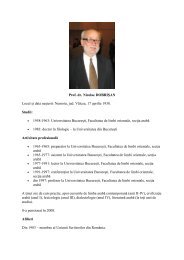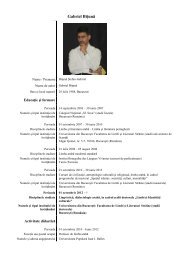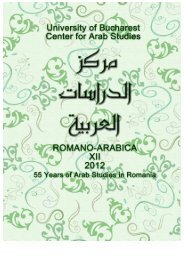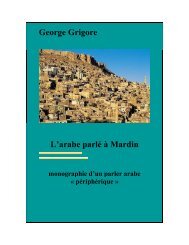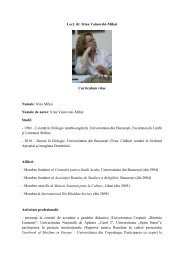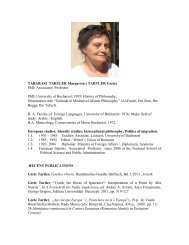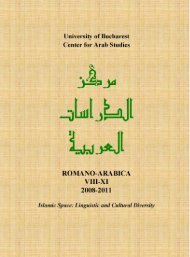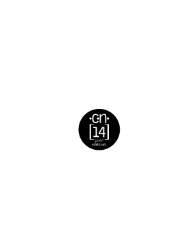University of Bucharest
University of Bucharest
University of Bucharest
You also want an ePaper? Increase the reach of your titles
YUMPU automatically turns print PDFs into web optimized ePapers that Google loves.
and nominal forms involving only the three radicals followed by a vowelbeginning<br />
suffix drop the vowel between the first and the second radical, e.g.<br />
nšidat ‗she asked‘. Other characteristics <strong>of</strong> the dialect <strong>of</strong> the ‗Amāra region and its<br />
surrounding marshlands include the pronunciation /ž/ as a reflex <strong>of</strong> jīm 11 , the<br />
occurrence <strong>of</strong> /ī/ as a reflex <strong>of</strong> the Classical Arabic diphthong /ay/ in certain nonverbal<br />
forms 12 , and the use <strong>of</strong> /‗ēb/ as a negative particle for verbs. 13<br />
3. Poems<br />
The poems in the volumes are written in Arabic with some necessary<br />
vowel signs for an easier comprehension 14 , but no Persian translation is given<br />
anywhere throughout the books. The explanatory panels between the poems as<br />
well as the biographies <strong>of</strong> the poets and the general introduction to the townships<br />
are all in Persian. This implies that the book was written for an audience who<br />
basically speak Persian and either belong to the Arabic-speaking minority or have<br />
some knowledge <strong>of</strong> Arabic and want to get acquainted with the literature <strong>of</strong> this<br />
minority.<br />
I am completely aware <strong>of</strong> the fact that a written dialectal material should<br />
always be treated carefully. One should by no means come to final and clear-cut<br />
conclusions regarding the dialectal features based on written texts. Such material,<br />
especially poems, does not by all means mirror the actual spoken language. My<br />
goal with this material is to show to what extent these texts are reliable in setting<br />
up the characteristics <strong>of</strong> the given dialect and how the well-known linguistic<br />
features peculiar to the region are attested in them. In the following some random<br />
excerpts from these panegyrical poems can be read. Through the first complete<br />
poem I intend to demonstrate some <strong>of</strong> the linguistic features <strong>of</strong> the area, whereas<br />
afterwards only some lines from other poems will be shown that have interesting<br />
characteristics. I, <strong>of</strong> course, do not have in mind to give a full phonological and<br />
morphological description <strong>of</strong> the dialect now because the features deduced from<br />
the texts all fit into the general characteristics <strong>of</strong> the Southern Mesopotamian gilitdialects.<br />
11 In the rest <strong>of</strong> Southern Mesopotamia and H~ūzistān the regular reflex <strong>of</strong> jīm is /y/ or /j/, see<br />
Johnstone 1965, 236-237ff. and Johnstone 1967, 9-11ff.<br />
12 Examples such as /h}wīza/ for H}uwayza and /dašt mīšān/ are given in Ingham 1997, 33.<br />
13 For a thorough elucidation <strong>of</strong> these regional contrasts, see Ingham 1997, 31-35.<br />
14 There are also poems originally written in Persian but these are out <strong>of</strong> the scope <strong>of</strong> our interest<br />
this time.<br />
42



